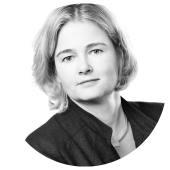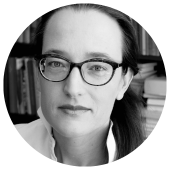Executive Committee
The Vice President, the Secretary General and the Treasurer are nominated for election in the General Assembly by the Executive Committee.
The Executive Committee has three seats for Counsellors. Nominations arise from the Executive Committee and from membership suggestions.

President:
M. Maas – Amsterdam University Medical Centers, Amsterdam, Netherlands
Term of Office: 2023-2024

Past President:
C. Martinoli – University of Genoa, Genoa, Italy
Term of Office: 2023-2024

A. Feydy – Hôpital Cochin, Paris, France
Term of Office: 2023-2024

P. Robinson – Chapel Allerton Hospital, Leeds, United Kingdom
Term of Office: 2023-2024

Treasurer:
S. Waldt – Alfried Krupp Krankenhaus Rüttenscheid, Essen, Germany
Term of Office: 2022-2025

Secretary:
M. Adriaensen – Zuyderland Medical Center, Heerlen, the Netherlands
Term of Office: 2023-2024

Councillor:
A. Gersing – University Hospital of the Ludwig Maximilians University of Munich, Munich, Germany
Term of Office: 2023-2025

M. Rupreht – University Medical Center Maribor, Maribor, Slovenia
Term of Office: 2023-2025

Councillor:
J. Fernández Jara – Sanitas La Zarzuela University Hospital, Madrid, Spain
Term of Office: 2023-2025
Honorary Members
2023…Ian Beggs (United Kingdom)
2023…Mario Padrón (Spain)
2022…Adam Mester (Hungary)
2022…Mark Davies (United Kingdom)
2019…Remide Arkun (Türkiye)
2019…Victor Cassar-Pullicino (United Kingdom)
2018…Ann-Grethe Jurik (Denmark)
2018…Jürg Hodler (Switzerland)
2017…Josef Kramer (Austria)
2016…Johan Bloem (the Netherlands)
2015…Carlo Faletti (Italy)
2014…Klaus Bohndorf (Germany)
2013…Francisco Aparisi Rodriguez (Spain)
2012…Judith Adams (United Kingdom) – Read Obituary, tribute RCR
2011…Maximilian Reiser (Germany)
2010…Iain McCall (United Kingdom)
2009…Alain Chevrot (France) – Read Obituary
2008…Vladimir Jevtic (Slovenia) – Read Obituary
2007…Herwig Imhof (Austria)
2006…AM De Schepper (Belgium) – Read Obituary
2005…Jean Garcia (Switzerland)
2005…Holger Pettersson (Sweden)
2004…Sandor Forgacs (Hungary)
2004…Iain Watt (United Kingdom)
2003…Jurgen Freyschmidt (Germany)
2002…Mario Cammisa (Italy) – Read Obituary
2001…Paul Butt (United Kingdom)
1999…Wolfgang Dihlmann (Germany)
1999…Harry Genant (United States of America) – Read Obituary
1998…Clement Faure (France)
1997…Dennis Stoker (United Kingdom)
1997…Walter Bessler (Switzerland)
1996…Friedrich Heuck (Germany) – Read Obituary
Past Officers
ESSR Representatives within ESR
ESR Subspecialties and Allied Sciences Committee:
automatically represented by the ESSR Society President
ESR Education Committee:
Elena Drakonaki (term: 2024-2026)
ESR Research Committee:
Edwin Oei (term: 2023-2025)
ESR Quality, Safety & Standards Committee:
Eva Llopis (term: 2024-2026)
Committees
Committees are created as required within the Society to support and strengthen the work of the Executive Committee (ExCom).
Members of the committees will be appointed by the ExCom or by the chairperson with the approval of the Ex Com.
Subcommittees
Subcommittees are created to support and to enhance the efforts of the ESSR in their special fields and especially to link to other radiological or non-radiological societies or working groups with similar fields of interest.
Members of ESSR are encouraged to become involved in the subcommittees.
Taskforces
A task force (interest group) can be considered a steering group without educational objectives..
Task forces will have a well-defined scope and objective to reach (incl. political, research) do not have the architecture and duties of a permanent subcommittee. Its duration is limited, ending at the completion of the task. It can be prolonged in case of new upcoming tasks.
Based on the needs/results/formative activities to accomplish, a task force may evolve into a subcommittee and a subcommittee may also evolve into a task force.
Artificial Intelligence Taskforce
Spine Taskforce
2023
- ESSR-ISS prize winner:
G. M. Kalisvaart, the Netherlands: Evaluation of response to neoadjuvant chemotherapy in osteosarcoma using dynamic contrast-enhanced MRI - ESSR-SSR prize winner:
M.O. De Maeseneer, Belgium: Wrist instability after sectioning the different components of the scafolunate ligament and DCSS using a cadaveric model - ESSR Poster Award winner:
K.Lam, United Kingdom: Ultrasound guided Cryoablation of Morton’s neuroma – case series including post-ablation MRI appearances - ESSR Poster Award winner:
M.Lejoly, Belgium: Follow-up of giant cell tumors of bone with CT and dynamic contrast enhanced-MRI during denosumab treatment - ESSR Presentation Award winner:
H. Banitalebi, Norway: Fatty infiltration of the paraspinal muscles is associated with postoperative leg pain in lumbar spinal stenosis - ESSR Presentation Award winner:
A. Anton Jiménez, Spain: Long-term effectiveness of CT-guided rupture of symptomatic lumbar facet synovial cysts
2022
- ESSR-ISS prize winner:
G.Schmid, Neuss/DE: The origin of lumbar synovial cysts and the space of Okada: an experimental CT-Arthrographic study in human specimen - ESSR-SSR prize winner:
T. Van Den Berghe, Lochristi/BE: Imaging findings and value of CT and (DCE-)MRI in monitoring denosumab therapy of giant cell tumors of bone. - ESSR Poster Award winner:
P.Robinson, Leeds/UK: Soft tissue sarcoma biopsy: A safe, well-tolerated technique with a high diagnostic yield. A 5-year review of more than 800 cases. - ESSR Poster Award winner:
K. Mertens, Belgium: Imaging of anatomic variants of the upper extremity - ESSR Presentation Award winner:
M. K. Meier, Bern/CH: Deep Learning Based Fully Automated 3D Models of Hip Labrum based on MR arthrography are feasible and allow detection of differences in labrum volume among different hip deformities: A pilot study - Quiz prize winner:
M. Lavens, Heverlee/NL
T. Neves, Maia/PT
2021
- ESSR-ISS prize winner:
R.M. Kiil, Aarhus N/DK: Anatomical variation at the sacroiliac joints in young adults. Estimated prevalence by CT and concomitant diagnostics by MRI - ESSR-SSR prize winner:
P. Omoumi, Lausanne/CH: Differentiation of Benign and Malignant Vertebral Compression Fractures Using Qualitative and Quantitative Analysis of a Single Fast Spin Echo T2-weighted Dixon Sequence - Prize for 2nd best oral presentation
S. Kamel, Philadelphia/US: Osgood or Osbad? Prevalence of Lateral Patellofemoral Maltracking and Associated Complications in Patients with Osgood Schlatter Disease - Prize for 3rd best oral presentation
F. Serpi, Milan/IT: Diffusion-weighted MRI radiomics classification of spinal bone tumors - Poster prize winner:
G. Petrocheilou, Athens/GR: Radiographic skeletal features of beta-Thalassemia. A pictorial essay and the background etiology. (EP)
P. Reyntiens, Antwerp/BE: Imaging of Dupuytren disease: what’s new? (SP) - Tumor prize winner:
J. Bodden, Munich/DE: Diagnosis of joint invasion in patients with malignant bone tumors: value and reproducibility of direct and indirect signs on MR imaging - Quiz prize winner:
not applicable
2020
- ESSR-SSR prize winner:
Danoob Dalili, Oxford/UK: Percutaneous sclerotherapy of spinal aneurysmal bone cysts causing neurological compromise: preliminary experience with a novel technique - Prize for 1st best poster presentation:
Hasan Banitalebi, Lorenskog/NO: Reliability of qualitative and quantitative imaging findings on X-ray and MRI in patients with lumbar spinal stenosis - Prize for 2nd best poster presentation:
Riccardo Picasso, Genova/IT: The role of high-resolution ultrasound in investigating the glenohumeral capsulo-ligamentous structures: a new proposal for an anterior approach
2019
- ESSR-ISS prize winner:
C. Hackenbroch, Ulm/DE: Metal artefact and dose reduction in CT imaging with orthopaedic implants: A comparison study of different available CT techniques - Prize for 2nd best oral presentation
F. Schmaranzer, Bern/CH: MRI-based 3D models of the pelvis can replace CT-based 3D models for range of motion analysis in femoroacetabular impingement - Prize for 3rd best oral presentation
A. Falkowski, Ann Arbor/US: Prevalence of pseudoerosions and morphology of joint capsules and recesses of the hand and wrist: ultrasound findings in 100 asymptomatic volunteers - Poster prize winner:
F. Diez Renovales, Bilbao/ES: Sacroiliac joint. How to differentiate inflammatory and non inflammatory conditions
A. G. F. Rose, Durban North/ZA: ACL Repair and Reconstruction: Keeping up to date with the role of MRI
A. Tereso, Amadora/PT: Postoperative Shoulder: Widening one’s knowledge in the MRI era - Quiz prize winner:
J. Desimpel H. Tuba Sanal
2018
- ESSR-ISS prize winner:
S. Badr, Lille/FR: Assessment of scapholunate joint laxity using speckle tracking echography: comparison with ligament status on CT arthrography - ESSR-SSR prize winner:
F. Zanchi, Lausanne/CH: Lumbar spine MRI: are T1 sagittal images still required when using T2 Dixon sequences? - Prize for 2nd best oral presentation
A. Isaac, London/UK: The added value of a CT based Modified Mirel’s classification in the management of skeletal metastases - Prize for 3rd best oral presentation
M. Stern, Ramat Gan/IL: Quadratus femoris muscle edema in the pediatric population - Poster prize winner:
S. Eminian, Clarens/CH: MRI characteristics of onychomatricoma
B. Kislinger, Frauenfeld/CH: Normal and abnormal MR imaging findings in the intrinsic muscles of the hand - Tumor prize winner:
B. Fritz, Zurich/CH: CT-based texture analysis of cartilaginous bone tumors for differentiation of enchondroma from low-grade chondrosarcoma and for low-grade from high-grade chondrosarcoma - Quiz prize winner:
J. Desimpel H. Tuba Sanal
2017
- ESSR-ISS prize winner:
R. Mirón Mombiela: Quantitative muscle ultrasound as an imaging biomarker for frailty syndrome - Poster prize winner:
A. Vidoni: Diagnostic algorithm for the evaluation of tumour and tumour-like lesions of the calcaneum
S. Döring: Ankle and mid foot ligaments revisited: US and MRI with anatomic correlation: A pictorial essay
A. Caetano: Axial spondyloarthritis – the role of imaging in diagnosis and management - Tumor prize winner:
Y. Maeder: T2-weighted SE Dixon sequence: a one-stop shop for the morphological assessment of bone marrow metastases? - Quiz prize winner:
J. Desimpel C. Cevikol
2016
- ESSR-ISS prize winner:
C. Mourad: Compression and delamination fractures in femoral head osteonecrosis : an MD-CT evaluation with micro-CT correlation - Poster prize winner:
S. Gitto: Dynamic high-resolution ultrasound of intrinsic and extrinsic ligaments of the wrist: how to make it simple
A. Arya: MRI characteristics of intraosseous lesions of the patella
M. De Maeseneer: High Resolution Ultrasound and MRI of the Ligaments, Tendons and Muscles of the MTP Joint of the Hallux: Cadaveric Correlation, Findings in Volunteers and Patients - Tumor prize winner:
S. Guerri: Magnetic resonance imaging guided high intensity focused ultrasound treatment for painful bone metastases - Quiz prize winner:
H. Umans
P.M. Yeap
2015
- ESSR-ISS prize winner:
S. Bensler: Is there a Difference in Treatment Outcomes between Epidural Injection Patients receiving Particulate versus non Particulate Steroids? - Poster prize winner:
N. Purohit: The “whys and wheres” of metal work around the shoulder
M. Vansevenant: Tendon pathologies at the elbow
G. Delimpasis: Peripheral nerve abnormalities: A pictorial review - Tumor prize winner:
T. Geith: Bone biopsy using an optical navigation system and comparison to fluoroscopic guidance - Quiz prize winner:
H.T. Sanal
M. Oliveira Castro
E. Sellon
2014
- ESSR-ISS prize winner:
A. Horng: Cartilage imaging in a guinea pig knee joint model of different ages using high resolution Propagation-based phase-contrast CT - Poster prize winner:
L.H.L. De Beuckeleer: Detection of clinically suspected scaphoid bone fractures using a dedicated cone-beam CT (CBCT). A retrospective study of 139 patients.
N. Skou: Patella position in the trochlea groove: comparison between supine and standing radiographs
J.M. Bondia Gracia: MRI of the Knee: A Proposal for a Systematic Reading - Tumour prize winner:
P. Jungmann: Neurovascular invasion by soft-tissue sarcoma: Assessment with MR imaging in 174 cases - Quiz prize winner:
N. Purohit
2013
- ESSR-ISS prize winner:
A. Moraux: Anatomical study of the indirect tendon of the rectus femoris using ultrasonography - Poster prize winner:
S. Baleato González: Imaging findings of soft tissue infections
J. Tuckett: Hydrodilatation for the treatment of frozen shoulder – our early experiences
D. K. Filippiadis: Trans-foraminal infiltration in the cervical spine through the ipsilateral facet joint: clinical experience and results - Tumour prize winner:
T. Geith: Quantitative dynamic contrast-enhanced MRI in the differentiation of benign and malignant vertebral body fractures - Quiz winner:
H. Tuba Sanal
J. Tang
2012
- ESSR-ISS prize winner:
T. Geith: Multiparameter assessment of osteoporotic and metastatic vertebral body fractures with MRI – Value of qualitative and quantitative diffusion weighted imaging - Poster prize winner:
Ph.A. Tyler: MR Arthogram of the hip: Pathology, pearls and pitfalls
Th. Moritz: Imaging in extraspinal sciatic neuropathy
S. van Vliet-Hein: Calcific shoulder tendinitis - Tumour prize winner:
H. Neubauer: Diffusion-weighted MRI of paediatric MSK Tumors - Quiz winner:
H.T. Sanal
E. de Smet
2011
- ESSR-ISS prize winner:
T. Dietrich: Supraacetabular Fossa (pseudo-defect of acetabular cartilage): Morphology at MR-arthrography and correlation with conventional radiographs - Poster prize winner:
V. Skiadas: Anterior knee pain. A pictorial essay
P. Mercouris: MRI of SLAP Lesions: A pictorial review of imaging and anatomy with arthoscopic correlation
E. Fabbro: Dynamic ultrasound evaluation (HRUS) of the hip: a detailed didactic approach - Tumour prize winner:
I. Tsifountoudis: MR imaging of tumours and tumour-like lesions of Hoffa’s fat pad - Quiz winner:
M. Alshaalam
A. Larbi
PARTNERS AND COOPERATIONS
The ESSR has cooperations with National Skeletal Radiology Societies to offer their members a reduced membership. We want to thank these societies for their cooperation and for fostering the exchange of expertise in musculoskeletal radiology on a European level.
ESSR is offering the full benefits for members of the cooperating national musculoskeletal society/group
National societies are asked to provide a list (template provided by ESSR) of their members who wish to join the ESSR at the reduced subscription rate. (Forwarding any member information to ESSR requires the personal confirmation and willingness by the respective individual, which has to be collected by the National Society.)
ESSR includes all given individual National Society members in the ESSR membership database.
The National Societies are kindly requested to collect the fees of the Individual Members and pay the collective group member fee to ESSR.
Contact our office for more information: office@essr.org
ESSR Partner Societies
- Musculoskeletal Section of Belgian Society of Radiology
- BSSR: British Society of Skeletal Radiology (joint membership cooperation)
- Danish Society for Skeletal Radiology (joint membership cooperation)
- Dutch Section of Musculoskeletal Radiology (joint membership cooperation)
- Finnish Musculoskeletal Society (joint membership cooperation)
- DGMSR: Germany Society of Musculoskeletal Radiology (joint membership cooperation)
- Hellenic Society of Musculoskeletal Radiology (joint membership cooperation)
- Musculoskeletal Section of Hungarian Society of Radiology
- ISSR: Irish Society of Skeletal Radiology
- Latvian MSK Group
- MSK Subcommittee of the Polish Medical Society of Radiology
- NFMSR: Norsk forening for muskel- og skjelettradiologi (joint membership cooperation)
- ÖRG – Austrian Society of Radiology (joint membership cooperation)
- Polish Medical Society of Radiology – Subcommittee of imaging diagnostics in sports medicine
- MSK Section of SPRMN – Portuguese Radiological Society
- Russian MSK Section
- Serbian Society of Musculoskeletal Radiology
- SERME: Sociedad Espanola de Radiología / Músculo-Esquelética (joint membership cooperation)
- SIMS: Societe d’Imagerie Musculo-Squelettique (joint membership cooperation)
- SIRM: Società Italiana di Radiologia Medica (joint membership cooperation)
- Slovenian Musculoskeletal Society
- Swedish MSK Association
- Swiss Society of Musculoskeletal Radiology
- MSK subspeciality of Turkish Radiology Society (joint membership cooperation
International Cooperations
The Asian Musculoskeletal Society (AMS) was formed in 1999, and consists of radiologists and other individuals with a special interest in musculoskeletal radiology and related fields.
The AMS aims to promote all aspects of musculoskeletal radiology in Asia. Details of the society’s objectives can be found in the AMS constitution.
For more Information: http://www.amsmsk.org/
ESSR Partnership with AMSIG
The Australasian Musculoskeletal Imaging Group (AMSIG) was founded in 1992. The group provides a forum for the professional development of musculoskeletal imaging in Australia and New Zealand. The AMSIG Annual Meeting & Conference is held around April or May each year. The group is also active in promoting education in musculoskeletal imaging, liaison with other similar groups internationally and provides representation on various government bodies.
For more information: http://www.amsig.org/
ESSR Partnership with ISS
The International Skeletal Society brings together leaders in musculoskeletal science, education and clinical practice. The society is international and multidisciplinary. ISS members represent over 30 countries.
For more information: https://internationalskeletalsociety.com/
ESSR Partnership with SSR
The Society of Skeletal Radiology (SSR) was founded in 1978. The SSR was created to address the issues of specialty recognition and representation, resident and fellowship training, research in musculoskeletal imaging and continuing education.
For more information: https://skeletalrad.org/
ESSR Partnership with MSS
The Society of Musculoskeletal Society (MSS) was founded in Februar 2013. The Indian Musculoskeletal Society has been launched to provide a platform for the exchange of knowledge in a rapidly advancing field of Musculoskeletal Radiology.
For more information: https://www.indianmss.org
ESSR Partnership with SAMSIG
The South African Musculoskeletal Imaging Group (SAMSIG) was established in 2005 by a committed cohort of radiologists who possess a distinct focus on musculoskeletal imaging. Initially, the primary objective of the group was to enhance the standard of MSK imaging in South Africa to meet international benchmarks.
MEMORANDUM OF UNDERSTANDING between SAMSIG and ESSR
For more information: https://www.samsig.co.za/
ESSR Partnership with ACR
The Colombian Association of Radiology (ACR), founded in 1945, is the association for the specialty of radiology and diagnostic imaging in Colombia and one of the most representative in Latin America.
MEMORANDUM OF UNDERSTANDING in progress
For more information: https://www.arrs.org/ARRSLIVE/ACR
ESSR Partnership with ESR
The European Society of Radiology (ESR) is an apolitical, non-profit organisation dedicated to strengthening and unifying European radiology to improve the diagnosis, treatment and prevention of diseases while offering their members opportunities to learn, connect and thrive.
For more information: https://www.myesr.org/about/esr-member-societies/
ESSR Partnership with ESOR
The European School of Radiology (ESOR) is an institution, fulfilling the mission of the European Society of Radiology (ESR) in the field of education. One of its main goals is to assist in harmonising radiological education in Europe.
For more information: https://www.esor.org/